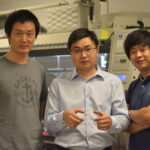

The ability to dissolve electronics has applications in the biomedical field, personal electronics and environmental safety, according to a UH news release. | Courtesy of assistant professor Cunjiang Yu
As a Tier One research university, UH made another discovery that could affect a spectrum of professions and fields.
Researchers from the University of Houston and China have laid the groundwork for research on electronics that dissolve when placed in contact with water molecules, which can lead to eco-friendly personal devices, according to a UH news release.
“This research is a breakthrough for the future of electronics since it is a totally novel concept to trigger transient electronics with environmental humidity,” said Kyoseung Sim, a materials science and engineering doctoral candidate.
The impact of dissolvable electronics is revolutionary across an array of fields, including defense. With this technology, sensitive, safeguarded information on electronics can be programmed to disappear.
In the biomedical field, devices that can dissolve could be triggered to do so at specific times once their usefulness runs out, mechanical engineering assistant professor Cunjiang Yu said.
Implantable devices typically require surgery to remove, but a dissolvable device would cut out the need for an additional surgery, Sim said.
Applying this science to personal electronics can create more eco-friendly devices.
Electronic waste, known as e-waste, represents two percent of America’s trash in landfills, according to DoSomething.org. The EPA estimated that in 2009, U.S. consumers and businesses discarded electronics totaling 2.37 million tons.
If new electronic devices are programmed to disappear, the impact of e-waste in landfills can be reduced.
Sim, who is now in his fourth year of doctoral study, has been guided by professor Yu and worked alongside other UH professors and students. Sim can design, fabricate and characterize each electronic device.
A paper on the subject was published in the journal Science Advances in early September.
But how do the electronics dissolve?
“Most people know acid is corrosive to metal,” Sim said. “In a certain level of humidity condition, the (supporting material) that has the electronic devices can generate acid to chemically dissolve the electronics.”
The model created for this research started with electronic components built onto a film made of polymer polyanhydride. Once moisture causes a chemical breakdown, the inorganic electronic materials and components are absorbed, according to the news release.
“The transient period of time can be controlled precisely based on not only humidity level of environment but also composition and dimension of polymer substrate,” said Sim.
The day mass produced electronics disappear after use has not yet arrived, but research conducted at UH is taking the far-fetched idea one step further.
news@thedailycougar.com
—
“Researchers make breakthrough on dissolving electronics” was originally posted on The Daily Cougar
